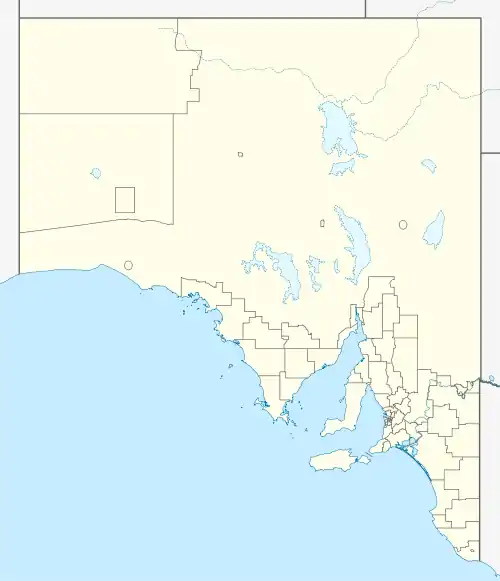Nixon-Skinner Conservation Park
Nixon-Skinner Conservation Park (formerly the Nixon-Skinner National Park Reserve) is a protected area located in the Australian state of South Australia in the locality of Myponga about 55 kilometres (34 mi) south of the state capital of Adelaide and about 3.5 kilometres (2.2 mi) south-west of the town of Myponga.[1][4]
| Nixon-Skinner Conservation Park Myponga[1], South Australia | |
|---|---|
IUCN category III (natural monument or feature)[2] | |
 Nixon-Skinner Conservation Park | |
| Nearest town or city | Myponga [1] |
| Coordinates | 35°24′41″S 138°26′00″E[2] |
| Established | 1 January 1956[3] |
| Area | 8 hectares (20 acres)[3] |
| Managing authorities | Department for Environment and Water |
| See also | Protected areas of South Australia |
The conservation park consists of land in section 245 in the cadastral unit of the Hundred of Myponga and which is bounded in the south by the Main South Road and to the east by the Myponga Reservoir.[1][4]
The conservation park began in 1948 as a gift of “20 acres of scrub land at Myponga for use as a natural history reserve” by Mrs. Lucy Page to the Field Naturalists Section of the Royal Society of South Australia and was named as the Nixon Skinner sanctuary in memory of her two grandfathers. On 1 January 1956, ownership of land was transferred to the Government of South Australia. On 9 November 1967, it was proclaimed under the National Parks Act 1966 as the Nixon-Skinner National Parks Reserve. On 27 April 1972, it was reconstituted as the Nixon-Skinner Conservation Park upon the proclamation of the National Parks and Wildlife Act 1972. On 24 February 1980, a plaque was unveiled by David Wotton, the then Environment Minister for South Australia, in the presence of Mrs Page's three surviving daughters to commemorate the donation of the land.[5][6][4][7][8] As of 2016, it covered an area of 8 hectares (20 acres).[3]
In 1980, it was described as follows:[4]
…Nixon-Skinner Conservation Park supports a stringybark open forest (Eucalyptus obliqua) in the north and central parts and a woodland of E. leucoxylon in the south. E. fasciculosa is a smaller tree scattered through the Park. A mid-dense under-storey includes a variety of sclerophyllous shrubs. Introduced grasses and some pest plants (eg Watsonia sp.) have become established in the south-western corner of the Park. Schoenus tenuissimus which is a rare plant in South Australia … occupies damp sites in the park, which is visited by the spectacular Calyptorhynchus funereus (yellow-tailed black cockatoo).
The conservation park is classified as an IUCN Category III protected area.[2] In 1980, it was listed on the now-defunct Register of the National Estate.[4]
See also
References
- "Search results for 'Nixon-Skinner Conservation Park' with the following datasets selected – 'Suburbs and Localities', 'NPW and Conservation Boundaries', 'Hundreds', 'Roads', 'Recreational Trails' and 'Gazetteer'". Location SA Map Viewer. South Australian Government. Retrieved 12 March 2018.
- "Terrestrial Protected Areas of South Australia (refer 'DETAIL' tab )". CAPAD 2016. Australian Government, Department of the Environment (DoE). 2016. Retrieved 21 February 2018.
- "Protected Areas Information System Reserve List" (PDF). Government of South Australia. 14 December 2016. Retrieved 27 December 2017.
- "Nixon Skinner Conservation Park, Main South Rd, Myponga, SA, Australia (Place ID 7774)". Australian Heritage Database. Department of the Environment. 21 October 1980. Retrieved 17 March 2018.
- "MOVE FOR OUTER BELT OF PARKS". The Advertiser (Adelaide). 91 (28089). South Australia. 16 October 1948. p. 3. Retrieved 16 March 2018 – via National Library of Australia.
- "Plaque marks gift of reserve". Victor Harbour Times. 68 (3, 007). South Australia. 27 February 1980. p. 24. Retrieved 16 March 2018 – via National Library of Australia.
- "No. 56 of 1972 (National Parks and Wildlife Act, 1972)". The South Australian Government Gazette. Government of South Australia: 660 & 700. 27 April 1972. Retrieved 27 February 2018.
- Walsh, Frank (9 November 1967). "NATIONAL PARKS ACT, 1966: VARIOUS NATIONAL PARKS NAMED" (PDF). South Australian Government Gazette. South Australian Government. p. 2043. Retrieved 17 March 2018.
 This article incorporates text by Commonwealth of Australia available under the CC BY 3.0 AU licence.
This article incorporates text by Commonwealth of Australia available under the CC BY 3.0 AU licence.